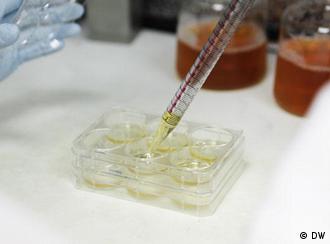Flu Kills Quickly, Taking Lives of 100 Healthy Children Annually
In just eight months at his new school in Rifle, Colo., Austin Booth made a name for himself as a star athlete, honor student and a popular classmate with a promising future.
But within six days after he contracted the flu last January, Austin was dead. He was 17. His parents had never even considered giving a flu shot to their otherwise healthy teen.
"It was flu season and we knew other kids who were sick and we didn't think that much about it," said his mother, Regina Booth, 42. "He was a healthy teenager."
"He was just one of those kids that excelled at everything," she said. "And he was the type of kid who made friends instantly."
"It was pretty tough -- and it seems like just yesterday," said Booth, who is 38 weeks pregnant and now annually immunizes her four other children, aged 3 to 16.
"Now that we are expecting a new baby, it protects us and the baby," she said.
Debunking Four of the Most Common Flu Shot Myths
Between 3,000 and 49,000 Americans die of influenza each year, according to the Centers for Disease Control and Prevention.More than 200,000 are hospitalized annually with flu-related complications like pneumonia.In the past four years, the CDC has changed its recommendations and now urges all Americans six months and older get a flu shot. Children under the age of 9, who are getting immunized for the first time, should get two doses, one month apart.
Booth said she still cannot believe how sudden her son's death was. On Tuesday night, he had started and played a full basketball game. By Wednesday night, he was coughing up blood and was rushed to the hospital with pneumonia."They intubated him as he struggled to breathe," said his mother. "It was the last time I talked to him."His father Carl, who worked on an oil rig and couldn't be reached, was never able to see his son conscious again. Austin was airlifted to St. Mary's Hospital in Grand Junction and at first, doctors thought he would survive.But soon, his condition got worse -- even on "every antibiotic in the world" -- and Austin had to be taken off the ventilator and manually "bagged." Tests showed the teen positive for the virulent infection MRSA."Doctor's said it was a perfect storm of pneumonia and MRSA," said Booth. "He fought Thursday until Monday, but it was more than his body could handle."Hundreds of Austin's new friends showed up for his funeral. The basketball team retired his #2 jersey and Austin was recognized with a school bench and a memory stone."We had never gotten the flu shot -- not any of us," she said. "We thought, we don't need it, we are healthy. If we get the shot it will make us sick."Dr. William Schaffner, professor and chairman of preventive medicine at Vanderbilt University in Nashville, said that people are fooled into thinking that influenza, a serious respiratory infection, is just like a cold."People use the word 'flu' very casually to refer to a whole variety of winter illnesses, including a stuffy nose, and that tends to trivialize it," said Schaffner. "It is a serious viral infection -- it wreaks havoc on all the body's systems.""Although it can be mild and often is, it is often very, very serious and can strike an otherwise normal child and put them in intensive care, usually within 48 hours."The most serious complications occur among older people, but each year children die of the disease -- and "it's potentially preventable," according to Schaffner."While it is an imperfect vaccine, it is the best influenza vaccine at the present time," he said. Though it does not always prevent infection, because viruses change each year, it can "turn a more serious flu into a milder one, so you won't die."With 120 million doses given each year in the U.S. alone, it is a "wonderfully safe" vaccine, whose only side effects can be a sore arm or, rarely, a day of fever. It cannot give a person the flu. "That's an urban myth," said Schaffner.
The vaccine is covered by insurance carriers and only costs about $30 out of pocket. But only about half of all children are immunized.
Advocacy efforts by the nonprofit organization Families Fighting the Fluwere part the gradual change of the CDC recommendation toward universal immunization.
About 100 American children die each year from the flu, according to its executive director, Laura Scott. "It's devastating."
"The more people who get vaccinated, the less disease there is that spreads," said Scott. "You can build a cocoon around your family. Even if you don't have the infant vaccinated, you still have to vaccinate everyone around that baby."
Julie Moise of Kansas City, Mo., lost her 7-month-old son Ian to the flu in 2003. He got sick just 10 days after he had received his first of two flu shots. Her other children had full doses of the vaccine and never got sick.
Moise, a 41-year-old flight attendant, said she was initially "unconcerned" when Ian was diagnosed with the flu by his pediatrician. But by the end of the first day, he was "panting." The doctor reassured her that was normal in a child with a fever.
"His panting turned into more of a sigh and I thought that was a good thing," said Moise. "But later the doctor told me that happens when people's organs are shutting down."
Moise, too, was bedridden with the flu and called her husband to come home from work and help. She called the doctor's office again.
"Glen walks in the door and the phone rings -- it's the nurse," she said. "He told her, 'I don't like his coloring, let's take him to the emergency room.' Then Ian stopped breathing."
Moise, who is trained in CPR, attempted to save Ian while they rushed to the ER. They stopped at a nearby fire station and rescue workers also tried unsuccessfully to revive the baby. He died that afternoon at the hospital.
"The message is: First of all, take the flu seriously," she said. "We didn't think healthy children die of the flu. It's a preventable disease … And it doesn't discriminate. It can hit anyone."
After their son's death, the Moises founded Ian's Rainbow Flu Foundationto raise awareness.
Those who have survived influenza say its effects can be devastating.
Luke Duvall, now 20, came down with the flu in October 2009, and it took him a whole year to recover fully.
One-third of his Atkins, Ark., high school was hit hard with that strain of the flu.
Duvall was rushed to the hospital by ambulance. He nearly collapsed in the shower because he couldn't breathe.
"My blood pressure was so low that they couldn't draw blood and I almost crashed in the ambulance on the road," he said. "They had to pull over and stabilize me."
The next morning he was flown to Little Rock, where he stayed for 34 days, much of the time in a coma and on a respirator. "At one time, they had 20 IVs pumping all kinds of things into me," he said.
Duvall spent 17 days in rehab because he had lost 36 of his 157 pounds. "I had to relearn how to walk and how to drink and eat," he said. "I had to relearn daily functions like dressing myself."
All this, according to Duvall, because one student who boarded a football bus for a game had the flu and infected the entire team.
"He was a star athlete," he said. "If he had just had the vaccine, all of this would have stopped. It would have ended there. You don't just get it for yourself, but for those around you. It's a cycle that keeps going."
ABC News information specialist Nicholas Tucker contributed to this report.
http://abcnews.go.com/Health/ColdandFlu/flu-claims-lives-100-children-year-deaths-preventable/story?id=17820500&page=2#.ULYI_uQsDp8










